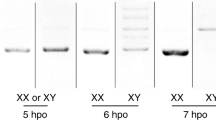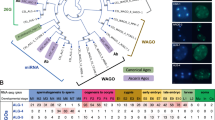Abstract
The nematode Caenorhabditis elegans has two sexes, males and hermaphrodites. Hermaphrodites initially produce sperm but switch to producing oocytes. This switch appears to be controlled by the 3′ untranslated region of fem-3 messenger RNA. We have now identified a binding factor (FBF) which is a cytoplasmic protein that binds specifically to the regulatory region of fem-3 3′UTR and mediates the sperm/oocyte switch. The RNA-binding domain of FBF consists of a stretch of eight tandem repeats and two short flanking regions. This structural element is conserved in several proteins including Drosophila Pumilio, a regulatory protein that controls pattern formation in the fly by binding to a 3′UTR. We propose that FBF and Pumilio are members of a widespread family of sequence-specific RNA-binding proteins.
This is a preview of subscription content, access via your institution
Access options
Subscribe to this journal
Receive 51 print issues and online access
$199.00 per year
only $3.90 per issue
Buy this article
- Purchase on Springer Link
- Instant access to full article PDF
Prices may be subject to local taxes which are calculated during checkout







Similar content being viewed by others
References
Wickens, M., Kimble, J. & Strickland, S. in Translational Control (eds Hershey, J., Mathews, M. & Sonenberg, N.) 411–450 (Cold Spring Harbor Laboratory Press, Cold Spring Harbor, (1996)).
Sonenberg, N. mRNA translation: influence of the 5′ and 3′ untranslated regions. Curr. Opin. Genet. Dev. 4, 310–315 (1994).
Beelman, C. A. & Parker, R. Degradation of mRNA in eukaryotes. Cell 81, 179–183 (1995).
Wickens, M., Anderson, P. & Jackson, R. Life and death in the cytoplasm: messages from the 3′ end. Curr. Opin. Genet. Dev. 7, 220–232 (1997).
Singer, R. RNA zipcodes for cytoplasmic addresses. Curr. Biol. 3, 719–721 (1993).
Curtis, D., Lehmann, R. & Zamore, P. D. Translational regulation and development. Cell 81, 171–178 (1995).
Anderson, P. & Kimble, J. in C. elegans II (eds Riddle, D. L., Blumenthal, T., Meyer, B. J. & Preiss, J. R.) 185–208 (Cold Spring Harbor Laboratory Press, Cold Spring Harbor, (1997)).
St Johnston, D. & Nüsslein-Volhard, C. The origin of pattern and polarity in the Drosophila embryo. Cell 68, 201–219 (1992).
Macdonald, P. & Smibert, C. A. Translational regulation of maternal mRNAs. Curr. Opin. Gen. Dev. 6, 403–407 (1996).
Wharton, R. Regulated expression from maternal mRNAs in Drosophila. Sem Dev. Biol. 3, 391–397 (1992).
St Johnston, D. The intracellular localization of messenger RNAs. Cell 81, 161–170 (1995).
Gebauer, R. & Richter, J. Synthesis and function of Mos: the control switch of vertebrate oocyte meiosis. BioEssays 19, 23–28 (1997).
Goodwin, E. B., Okkema, P. G., Evans, T. C. & Kimble, J. Translational regulation of tra-2 by its 3′ untranslated region controls sexual identity in C. elegans. Cell 75, 329–339 (1993).
Ahringer, J. & Kimble, J. Control of the sperm–oocyte switch in Caenorhabditis elegans hermaphrodites by the fem-3 3′ untranslated region. Nature 349, 346–348 (1991).
Hodgkin, J. Sex determination in the nematode C. elegans : analysis of tra-3 suppressors and characterization of fem genes. Genetics 114, 15–52 (1986).
Barton, M. K., Schedl, T. B. & Kimble, J. Gain-of-function mutations of fem-3, a sex-determination gene in Caenorhabditis elegans. Genetics 115, 107–119 (1987).
Ahringer, J., Rosenquist, T. A., Lawson, D. N. & Kimble, J. The Caenorhabditis elegans sex determining gene fem-3 is regulated post-transcriptionally. EMBO J. 11, 2303–2310 (1992).
Ahringer, J. Post-transcriptional regulation of fem-3, a sex-determining gene of C. elegans. Ph.D. thesis, University of Wisconsin-Madison((1991)).
SenGupta, D. et al. Athree-hybrid system to detect RNA-protein interactions in vivo. Proc. Natl Acad. Sci. USA 93, 8496–8501 (1996).
Murata, Y. & Wharton, R. Binding of Pumilio to maternal hunchback mRNA is required for posterior patterning in Drosophila embryos. Cell 80, 747–756 (1995).
Waterston, R. H., Sulston, J. E. & Coulson, A. R. in C. elegans II (eds Riddle, D. L., Blumenthal, T., Meyer, B. J. & Priess, J. R. ) 23–45 (Cold Spring Harbor Laboratory Press, Cold Spring Harbor, (1997)).
Austin, J. & Kimble, J. glp-1 is required in the germ line for regulation of the decision between mitosis and meiosis in C. elegans. Cell 51, 589–599 (1987).
Guo, S. & Kemphues, K. J. par-1, a gene required for establishing polarity in C. elegans embryos, encodes a putative Ser/Thr kinase that is asymmetrically distributed. Cell 81, 611–620 (1995).
Rocheleau, C. E. et al. Wnt signaling and an APC-related gene specify endoderm in early C. elegans embryos. Cell 90, 707–716 (1997).
Ward, S., Roberts, T., Strome, S., Pavalko, F. & Hogan, E. Monoclonal antibodies that recognize a polypeptide antigenic determinant shared by multiple Caenorhabditis elegans sperm-specific proteins. J. Cell Biol. 102, 1778–1786 (1986).
Meyer, B. J. in C. elegans II (eds Riddle, D. L., Blumenthal, T., Meyer, B. J. & Priess, J. R. ) 209–240 (Cold Spring Harbor Laboratory Press, Cold Spring Harbor, (1997)).
Shedl, T. & Kimble, J. fog-2, a germ-line specific sex determination gene required for hermaphrodite spermatogenesis in Caenorhabditis elegans. Genetics 119, 43–61 (1988).
Hodgkin, J. More sex-determination mutants of Caenorhabditis elegans. Genetics 96, 649–664 (1980).
Fu, X.-d. The superfamily of arginine/serine-rich splicing factors. RNA 1, 663–680 (1995).
Valcarcel, J. & Green, M. The SR protein family: pleiotropic functions in pre-mRNA splicing. Trends Biochem. Sci. 21, 296–301 (1996).
Macdonald, P. The Drosophila pumilio gene: an unusually long transcription unit and an unusual protein. Development 114, 221–232 (1992).
Barker, D., Wang, C., Moore, J., Dickinson, L. & Lehmann, R. Pumilio is essential for function but not for distribution of the Drosophila abdominal determinant Nanos. Genes Dev. 6, 2312–2326 (1992).
Graham, P. L. & Kimble, J. The mog-1 gene is required for the switch from spermatogenesis to oogenesis in Caenorhabditis elegans. Genetics 133, 919–931 (1993).
Graham, P. L., Schedl, T. & Kimble, J. More mog genes that influence the switch from spermatogenesis to oogenesis in the hermaphrodite germ line of Caenorhabditis elegans. Dev. Genet. 14, 471–484 (1993).
Schedl, T., Graham, P. L., Barton, M. K. & Kimble, J. Analysis of the role of tra-1 in germline sex determination in the nematode Caenorhabditis elegans. Genetics 123, 755–769 (1989).
Coglievina, M., Bertani, I., Klima, R., Zaccaria, P. & Bruschi, C. The DNA sequence of a 7941 bp fragment of the left arm of chromosome VII of Saccharomyces cerevisiae contains four open reading frames including the multicopy suppressor gene of the pop2 mutation and a putative serine/threonine protein kinase gene. Yeast 11, 767–774 (1995).
Zamore, P., Williamson, J. & Lehmann, R. The Pumilio protein binds RNA through a conserved domain that defines a new class of RNA-binding protein. RNA (in the press).
Birney, E., Kumar, S. & Krainer, A. Analysis of the RNA-recognition motif and RS and RGG domains: conservation in metazoan pre-mRNA splicing factors. Nucleic Acids Res. 21, 5803–5816 (1993).
Nagai, K., Oubridge, C., Ito, N., Avis, J. & Evans, P. The RNP domain: a sequence-specific RNA-binding domain involved in processing and transport of RNA. Trends Biochem. Sci. 20, 235–240 (1995).
Wharton, R. P. & Struhl, G. RNA regulatory elements mediate control of Drosophila body pattern by the posterior morphogen nanos. Cell 67, 955–967 (1991).
Curtis, D. et al. ACCHC metal-binding domain in Nanos is essential for translational regulation. EMBO J. 16, 834–843 (1997).
Lehmann, R. & Nüsslein-Volhard, C. The maternal gene nanos has a central role in posterior pattern formation in the Drosophila embryo. Development 112, 679–691 (1991).
Wang, C., Dickinson, L. & Lehmann, R. Genetics of nanos localization in Drosophila. Dev. Dynam. 199, 103–115 (1994).
Fitch, D. H. A. & Thomas, W. K. in C. elegans II (eds Riddle, D. L., Blumenthal, T., Meyer, B. J. & Priess, J. R. ) 815–850 (Cold Spring Harbor Laboratory Press, Cold Spring Harbor, (1997)).
Crittenden, S. L., Troemel, E. R., Evans, T. C. & Kimble, J. GLP-1 is localized to the mitotic region of the C. elegans germ line. Development 120, 2901–2911 (1994).
Hodgkin, J. in C. elegans II (eds Riddle, D. L., Blumenthal, T., Meyer, B. J. & Priess, J. R.) 881–1047 (Cold Spring Harbor Laboratory Press, Cold Spring Harbor, (1997)).
Acknowledgements
We thank R. Lehmann, C. Mello, J. Priess, R. Wharton and J. Williamson for communicating results before publication and for discussion; P. Anderson for comments on the manuscript; R. Barstead for C. elegans cDNA libraries; A. Coulson for YAC grids; the C. elegans sequencing consortium for unpublished genomic sequences; S. Ward for anti-sperm antibodies; and U.W. Biochemistry Media Laboratory for help with preparing the figures. DNA sequencing was performed at the UW Biotechnology Center. This work was supported by grants from the NIH to J.K. and M.W., from the NSF Science and Technology Center (Seattle) to S.F. and M.W., and by EMBO and Fonds National Suisse fellowships to A.P., J.K. and S.F. are investigators with the Howard Hughes Medical Institute.
Author information
Authors and Affiliations
Corresponding author
Rights and permissions
About this article
Cite this article
Zhang, B., Gallegos, M., Puoti, A. et al. A conserved RNA-binding protein that regulates sexual fates in the C. elegans hermaphrodite germ line. Nature 390, 477–484 (1997). https://doi.org/10.1038/37297
Received:
Accepted:
Issue Date:
DOI: https://doi.org/10.1038/37297
This article is cited by
-
Genome-wide identification of RNA recognition motif (RRM1) in Brassica rapa and functional analysis of RNA-binding protein (BrRBP) under low-temperature stress
BMC Plant Biology (2023)
-
A comprehensive thermodynamic model for RNA binding by the Saccharomyces cerevisiae Pumilio protein PUF4
Nature Communications (2022)
-
Structural and functional similarities and differences in nucleolar Pumilio RNA-binding proteins between Arabidopsis and the charophyte Chara corallina
BMC Plant Biology (2020)
-
Role of the Pumilio gene in the reproductive system of Schistosoma japonicum
Parasitology Research (2020)
-
Functions, mechanisms and regulation of Pumilio/Puf family RNA binding proteins: a comprehensive review
Molecular Biology Reports (2020)
Comments
By submitting a comment you agree to abide by our Terms and Community Guidelines. If you find something abusive or that does not comply with our terms or guidelines please flag it as inappropriate.



